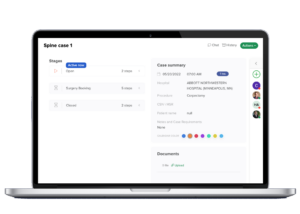Effective medical inventory management is crucial for the smooth operation of healthcare facilities. Properly managed inventory ensures that medical professionals have timely access to necessary supplies, thereby improving patient care and outcomes. In this article, we’ll explore the importance of medical inventory management and how advanced software solutions can revolutionize this process.

The Importance of Medical Inventory Management
Efficient medical inventory management is essential in healthcare settings to prevent shortages and overstocking of supplies. By accurately tracking inventory, healthcare facilities can maintain an optimal level of supplies, avoiding the pitfalls of both excess and deficiency. This balance directly impacts patient care, financial stability, and operational efficiency.
The Impact of Inventory Levels on Healthcare Operations
Sales and Customer Satisfaction
Maintaining proper inventory levels ensures that healthcare providers can meet patient needs without delay. If a healthcare facility runs out of essential supplies, it may not be able to provide timely care, leading to decreased patient satisfaction and potentially harmful delays in treatment. Conversely, overstocking can tie up valuable resources and increase storage costs, which can strain a facility’s budget.
Proper inventory levels help healthcare providers respond swiftly to patient needs, enhancing satisfaction and trust. This efficiency boosts a facility’s reputation and strengthens its relationships with patients and suppliers.
Cash Flow and Profitability
Inventory levels have a direct impact on a healthcare facility’s cash flow and profitability. Holding excess inventory ties up capital and increases storage costs, while insufficient inventory can lead to stockouts and disrupt patient care. By maintaining optimal inventory levels, healthcare facilities can balance having enough stock to meet demand and avoiding excess costs, leading to improved cash flow and profitability.
Effective medical inventory management can also reduce waste from expired or obsolete supplies, further enhancing financial stability and allowing more funds to be allocated to patient care and facility improvements.
Forecasting Demand for Inventory Planning
Accurate demand forecasting is essential for effective medical inventory management. It involves predicting future demand for medical supplies based on various factors, such as historical usage data, patient trends, and seasonal variations. Advanced inventory management software can analyze these factors to help healthcare facilities maintain optimal inventory levels.
Utilizing Advanced Software for Better Inventory Management
Modern inventory management software offers robust solutions for tracking and managing medical supplies. These systems provide real-time data on inventory levels, usage patterns, and expiration dates, enabling healthcare facilities to make informed decisions about ordering and stocking supplies.
Features and Benefits of Inventory Management Software
Real-Time Inventory Tracking: Advanced software allows for real-time tracking of inventory levels, ensuring that healthcare providers always know what supplies are available and when they need to reorder.
Automated Alerts: Automated alerts for low stock levels or upcoming expiration dates help prevent stockouts and reduce waste from expired items.
Analytics and Reporting: Detailed analytics and reporting tools provide insights into usage patterns, helping facilities optimize their inventory levels and reduce costs.
Integration with Other Systems: Integration with electronic health records (EHR) and other systems ensures that inventory management is seamless and efficient, reducing administrative burdens.
Steps for Effective Inventory Planning
Analyze Demand Forecasts: The first step in inventory planning is analyzing demand forecasts to determine expected usage based on historical data and current trends.
Consider Lead Times: Understanding the lead time for ordering and receiving supplies is crucial to maintaining proper inventory levels. Facilities should plan their orders to ensure they have enough stock to meet patient needs without overstocking.
Evaluate Storage Capacity: Assessing storage capacity helps facilities avoid overstocking and manage storage costs effectively.
Implement Inventory Management Software: Utilizing advanced software solutions can streamline inventory management, reduce errors, and enhance decision-making.
Continuous Monitoring and Adjustment: Inventory planning is an ongoing process. Continuous monitoring and adjustments based on real-time data help maintain optimal inventory levels.
Conclusion
Proper medical inventory management is essential for healthcare facilities to ensure they can meet patient needs, improve operational efficiency, and maintain financial stability. By utilizing advanced inventory management software and effective inventory planning, healthcare providers can optimize their inventory levels, reduce costs, and enhance patient care. Investing in robust inventory management systems is a crucial step towards achieving better patient outcomes and a more efficient healthcare operation.
About HUB Healthcare
HUB Healthcare is an innovative software platform designed to improve patient care through enhanced collaboration among facilities, providers, patients, and vendors. Our comprehensive solution addresses common challenges in the healthcare industry, such as disorganized communication, workflow bottlenecks, document management, task tracking, scheduling conflicts, security and compliance issues, and inventory management. With features like real-time inventory tracking, automated alerts, and seamless integration with other systems, HUB Healthcare revolutionizes medical inventory management, helping healthcare providers maintain optimal inventory levels, reduce costs, and enhance patient care. By streamlining operations and improving efficiency, HUB Healthcare supports healthcare facilities in achieving better patient outcomes and maintaining financial stability.
Additionally, HUB Healthcare offers tools like a medical imaging viewer for analyzing diagnostic images, ensuring seamless care coordination through integrated clinical pathways, and enhancing healthcare communication with automated messaging. Our platform also supports healthcare analytics for real-time performance evaluation, and functions as a robust care coordination platform. It includes features like compliance management system, patient management software, and healthcare document management to ensure comprehensive and efficient healthcare delivery.






